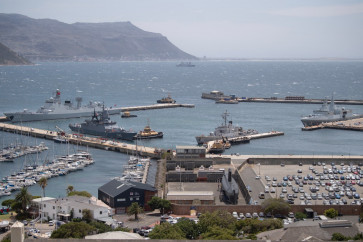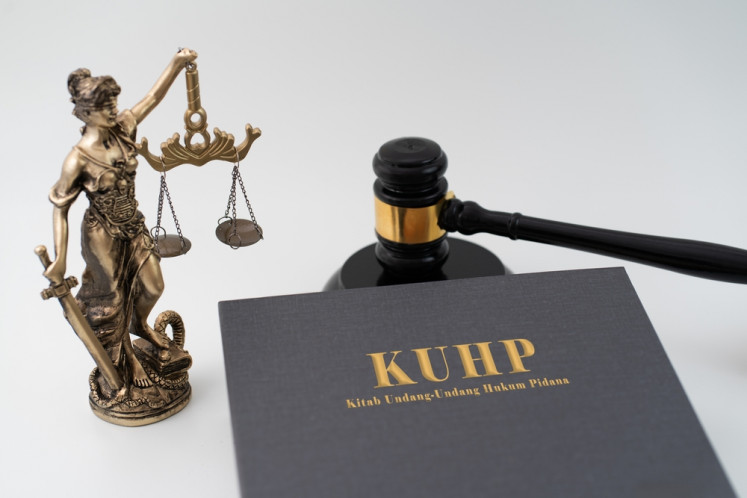Popular Reads
Top Results
Can't find what you're looking for?
View all search resultsPopular Reads
Top Results
Can't find what you're looking for?
View all search resultsLuhut: Only 1,000 died in 1965-66
Reconciliation: Sinta Nuriyah Wahid (right), the wife of late president Abdurrahman “Gus Dur” Wahid, greets 1965 Tragedy Victims Research Foundation West Sumatra branch chair Nadiani during a national symposium on the events of 1965 in Jakarta on Monday
Change text size
Gift Premium Articles
to Anyone
R
span class="caption">Reconciliation: Sinta Nuriyah Wahid (right), the wife of late president Abdurrahman “Gus Dur” Wahid, greets 1965 Tragedy Victims Research Foundation West Sumatra branch chair Nadiani during a national symposium on the events of 1965 in Jakarta on Monday.(JP/Don)
The first ever national conference to review one of the darkest periods in the country’s history came up against a brick wall on Monday with the government refusing to recognize the estimated number of people killed in anticommunist violence in 1955-1966.
In an apparent move to understate the scale of the atrocities, which saw the Indonesian communist movement functionally wiped out, the government challenged claims that hundreds of thousands of people were killed during the events, which also saw the rise of Soeharto, the longest-serving ruler in the nation’s history.
Coordinating Political, Legal and Security Affairs Minister Luhut Pandjaitan said that the government would not apologize for the incident, citing a lack of evidence to back up the claims of murder and repression.
“We know what we are doing and what is best for this country. I am 68 years old and I have lived through many important national events. I almost sacrificed my life for this country. I’ll be damned if this country is controlled by other countries,” said the retired Army general.
Luhut made the statement even before hearing the conclusion of the symposium, titled “Dissecting the Tragedy of 1965: The Historical Approach”, spearheaded by the National Commission on Human Rights (Komnas HAM) and the Presidential Advisory Board (Wantimpres).
The 1965 tragedy was sparked by the assassination of seven Army generals in September 1965, allegedly by a group launching an abortive coup against then president Sukarno.
Soeharto, then the commander of the Army Strategic Reserves Command (Kostrad), stepped in, defeating the group and accusing the Indonesian Communist Party (PKI), a powerful ally of Sukarno, of being behind the coup.
He subsequently usurped power from Sukarno and formed a new government that unleashed a campaign against communism, leading to a spate of killings carried out by civilian and military groups.
Throughout his 32-year rule in the country, Soeharto continued to propagate fear and hatred against PKI ideology and associates, leading to discrimination against anyone suspected or accused of being a communist.
The two-day conference in Jakarta aims to examine the killings that took place from 1965 to 1966 under the pretext of the communist purge through testimony provided by experts, survivors of the atrocities and members of the military.
The event was initially welcomed in light of the government’s reluctance to follow up Komnas HAM’s 2012 report finding that Soeharto and Command for the Restoration of Security and Order (Kopkamtib) officials had systematically organized the violence.
However, mystery still shrouds many of the details of the period, and no entity has ever ventured an official death toll.
Estimates range from a conservative 500,000 to as many as 3 million, a figure once boastingly cited by Sarwo Edhie Wibowo, who, as the chief of the Army’s Special Forces (Kopassus), headed the military campaign.
Luhut on Monday insisted that the actual number was much lower, citing a statement from retired Army general Sintong Panjaitan, who helped lead a Kopassus platoon during the time of the killings.
“Can you prove it by showing us one mass grave? Show me and I’ll go there,” he said. “I don’t believe the number was more than 1,000, probably less.”
Sintong said that the figure was closer to 80,000 deaths, based on a figure found by a “fact-finding team” formed by Sukarno and led by former home minister Soemarno.
“In December 1965, we returned from our mission in Central Java. After we finished our operation, the fact-finding team said that 80,000 people had died,” Sintong said.
The figure most popularly cited by historians, 500,000, was first uttered by a minister under Sukarno, Oei Tjoe Tat, he claimed.
“[Sukarno] asked Oeo Tjoe Tat and he gave a figure six times [the actual figure], so around 500,000. That was the first report to say 500,000 victims, and was considered the most accurate figure,” he said.
Reza Muharam, a member of the international people’s tribunal (IPT) on the 1965 tragedy, said that Lintong’s claim was a gross underestimation.
“The CIA [US Central Intelligence Agency] itself has said that it was one of the worst mass murders of the 20th century. We cannot ignore that,” he said. “I question the government’s commitment to solving this case. If it is truly serious, then don’t limit yourself by saying that you won’t apologize. That should only be a final conclusion after receiving input from this symposium.”










